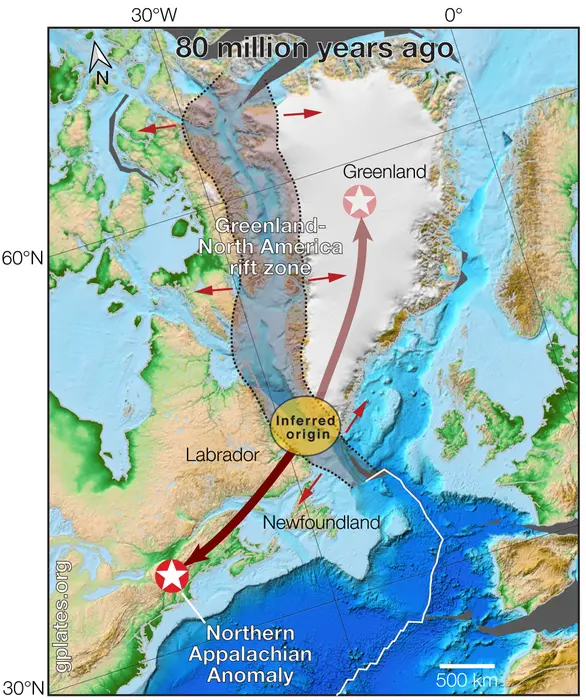An area of anomalously hot rocks 200 kilometers (120 miles) beneath the northern Appalachian Mountains could be the product of a continental divorce when dinosaurs still ruled, geologists claim. The presence of this deep heat has been known for a while, but the most common explanation has been an even older rift with Africa.
The Earth is dotted with hot zones deep beneath our feet. Some of these have known causes, such as current mantle plumes or zones where one tectonic plate is riding over another. Other such zones are more mysterious; likely the legacy of past events, but what these events were can be hard to determine.
One such enigma is the Northern Appalachian Anomaly (NAA), which is centered under New Hampshire and is about 400 km (240 miles) across, although stretched in the northeast-southwest direction the mountains run. Modeling has led Professor Tom Gernon of the University of Southampton and co-authors to suspect the NAA is so anomalous because it started between Canada and Greenland, and migrated 1,800 km (1,100 miles) to its current location.
The Appalachians are a particularly old mountain range – at a billion years or more, John Denver wasn’t kidding when he called them older than (land) life. That made it implausible that the heat was left over from their formation, besides the fact that the hot spot doesn’t cover the range’s full length. However, identifying a more recent cause has proven difficult, leading geologists to think the origins probably lay in the breakup of Pangea.
“This thermal upwelling has long been a puzzling feature of North American geology. It lies beneath part of the continent that’s been tectonically quiet for 180 million years, so the idea it was just a leftover from when the landmass broke apart never quite stacked up,” Gernon said in a statement.
Last year, the idea of “mantle waves” shook up geology, and Gernon and co-authors decided to see if it could explain the NAA. The theory holds that when continents separate, hot, dense rock at the base of tectonic plates peels away and can travel along a continent’s underside, causing unexpected phenomena far from the original site.
Greenland is considered part of the North American Plate, but an upwelling beneath what is now the Labrador Sea has been driving a separation for almost half the time the Atlantic Ocean has been growing; they’re just moving more slowly relative to each other.
Modeling of mantle wave behavior suggests that if one was produced on the American side of the separation, it would likely flow to where the NAA is now. Professor Sasha Brune of the Helmholtz Center for Geosciences said, “Convective instabilities cause chunks of rock, several tens of kilometres thick, to slowly sink from the base of the Earth’s outer layer, known as the lithosphere. As the lithosphere thins, hotter mantle material rises to take its place, creating a warm region known as a thermal anomaly.”
The anomaly is moving at just 22 km (13 miles) per million years, similar to the rate of movement of the slower tectonic plates. At that rate, it will pass beneath New York in about 15 million years.

The suspected path of the North Appalachian Anomaly in relation to the rift zone where it originated and its Greenland counterpart.
Image Credit: University of Southampton
If hot zones can form beneath one side of a plate division, it’s not surprising that a mirror image can occur on the other side. The authors think a known hot zone beneath north-central Greenland that causes ice there to flow more rapidly likely started on the opposite side of the Labrador division before migrating.
The Central Appalachian Anomaly (CAA) also exists, and as its name suggests, lies further south. The authors consider it possible that the CAA could be the result of an earlier wave hot blob if the Labrador rifting started in the late Jurassic, well before the break-up itself began.
“Our research suggests it’s part of a much larger, slow-moving process deep underground that could potentially help explain why mountain ranges like the Appalachians are still standing,” Gernon said. “Heat at the base of a continent can weaken and remove part of its dense root, making the continent lighter and more buoyant, like a hot air balloon rising after dropping its ballast. This would have caused the ancient mountains to be further uplifted over the past few million years.”
“The legacy of continental breakup on other parts of the Earth system may well be far more pervasive and long-lived than we previously realized,” Gernon added.
If you’re still confused about why claiming Greenland seemed to be such a priority early in this current administration, deep geological time probably isn’t the place to look. Nevertheless, it seems that part of the United States is apparently still hot under the collar about being left 80 million years ago.
The study is open access in Geology.
Source Link: “Hot Rock” Under Appalachians Traveled From Greenland To US At 20 Kilometers Per Million Years – And Is Still Moving